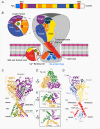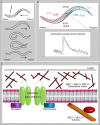The diverse functions of the DEG/ENaC family: linking genetic and physiological insights
- PMID: 36314992
- PMCID: PMC10148893
- DOI: 10.1113/JP283335
The diverse functions of the DEG/ENaC family: linking genetic and physiological insights
Abstract
The DEG/ENaC family of ion channels was defined based on the sequence similarity between degenerins (DEG) from the nematode Caenorhabditis elegans and subunits of the mammalian epithelial sodium channel (ENaC), and also includes a diverse array of non-voltage-gated cation channels from across animal phyla, including the mammalian acid-sensing ion channels (ASICs) and Drosophila pickpockets. ENaCs and ASICs have wide ranging medical importance; for example, ENaCs play an important role in respiratory and renal function, and ASICs in ischaemia and inflammatory pain, as well as being implicated in memory and learning. Electrophysiological approaches, both in vitro and in vivo, have played an essential role in establishing the physiological properties of this diverse family, identifying an array of modulators and implicating them in an extensive range of cellular functions, including mechanosensation, acid sensation and synaptic modulation. Likewise, genetic studies in both invertebrates and vertebrates have played an important role in linking our understanding of channel properties to function at the cellular and whole animal/behavioural level. Drawing together genetic and physiological evidence is essential to furthering our understanding of the precise cellular roles of DEG/ENaC channels, with the diversity among family members allowing comparative physiological studies to dissect the molecular basis of these diverse functions.
Keywords: DEG/ENaCs; acid-sensing ion channels; degenerins; epithelial Na+ channels; pickpockets.
© 2022 MRC Laboratory of Molecular Biology. The Journal of Physiology published by John Wiley & Sons Ltd on behalf of The Physiological Society.
Conflict of interest statement
The authors have no competing interests to declare.
Figures



Similar articles
-
Physiological insight into the conserved properties of Caenorhabditis elegans acid-sensing degenerin/epithelial sodium channels.J Physiol. 2023 May;601(9):1625-1653. doi: 10.1113/JP283238. Epub 2022 Oct 23. J Physiol. 2023. PMID: 36200489 Free PMC article.
-
A glial DEG/ENaC channel functions with neuronal channel DEG-1 to mediate specific sensory functions in C. elegans.EMBO J. 2008 Sep 17;27(18):2388-99. doi: 10.1038/emboj.2008.161. Epub 2008 Aug 14. EMBO J. 2008. PMID: 18701922 Free PMC article.
-
Peripheral and central employment of acid-sensing ion channels during early bilaterian evolution.Elife. 2023 Feb 23;12:e81613. doi: 10.7554/eLife.81613. Elife. 2023. PMID: 36821351 Free PMC article.
-
Mechanotransduction: touch and feel at the molecular level as modeled in Caenorhabditis elegans.Mol Neurobiol. 2007 Dec;36(3):254-71. doi: 10.1007/s12035-007-8009-5. Epub 2007 Sep 27. Mol Neurobiol. 2007. PMID: 17955200 Review.
-
Neuropeptides and degenerin/epithelial Na+ channels: a relationship from mammals to cnidarians.J Physiol. 2023 May;601(9):1583-1595. doi: 10.1113/JP282309. Epub 2022 Dec 8. J Physiol. 2023. PMID: 36479972 Review.
Cited by
-
Structural basis for excitatory neuropeptide signaling.Nat Struct Mol Biol. 2024 Apr;31(4):717-726. doi: 10.1038/s41594-023-01198-y. Epub 2024 Feb 9. Nat Struct Mol Biol. 2024. PMID: 38337033 Free PMC article.
-
Diarylamidine activation of a brachiopod DEG/ENaC/ASIC channel.J Biol Chem. 2025 Jan;301(1):108066. doi: 10.1016/j.jbc.2024.108066. Epub 2024 Dec 10. J Biol Chem. 2025. PMID: 39662830 Free PMC article.
-
A Conceptual Review of Naturally Occurring Toxins and Venoms as Peptide Blockers to Combat Chronic Low Back Pain.JOR Spine. 2025 Aug 15;8(3):e70107. doi: 10.1002/jsp2.70107. eCollection 2025 Sep. JOR Spine. 2025. PMID: 40821360 Free PMC article. Review.
-
Role of epithelial sodium channel-related inflammation in human diseases.Front Immunol. 2023 Jul 25;14:1178410. doi: 10.3389/fimmu.2023.1178410. eCollection 2023. Front Immunol. 2023. PMID: 37559717 Free PMC article. Review.
-
Flipping the switch: Illuminating inverted ligand activation of peptide-gated ion channels.Biophys J. 2025 Apr 1;124(7):1038-1041. doi: 10.1016/j.bpj.2025.02.027. Epub 2025 Mar 3. Biophys J. 2025. PMID: 40040284 No abstract available.
References
-
- Adams, C. M. , Snyder, P. M. , & Welsh, M. J. (1999b). Paradoxical stimulation of a DEG/ENaC channel by amiloride. Journal of Biological Chemistry, 274(22), 15500–15504. - PubMed
-
- Ainsley, J. A. , Pettus, J. M. , Bosenko, D. , Gerstein, C. E. , Zinkevich, N. , Anderson, M. G. , Adams, C. M. , Welsh, M. J. , & Johnson, W. A. (2003). Enhanced locomotion caused by loss of the Drosophila DEG/ENaC protein Pickpocket1. Current Biology, 13(17), 1557–1563. - PubMed
Publication types
MeSH terms
Substances
Grants and funding
LinkOut - more resources
Full Text Sources
Molecular Biology Databases

